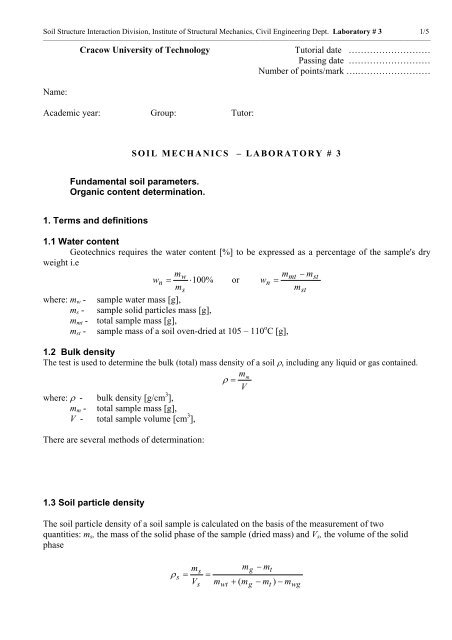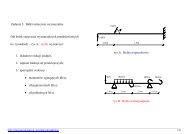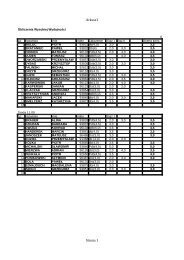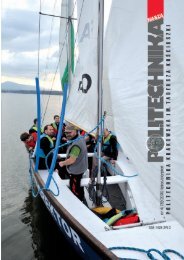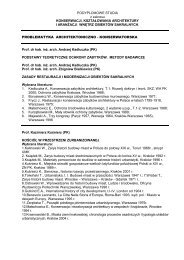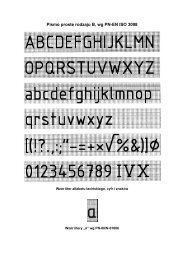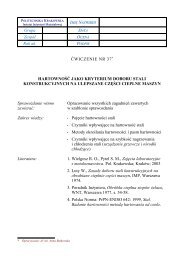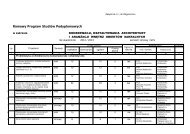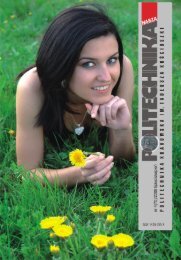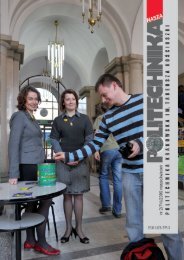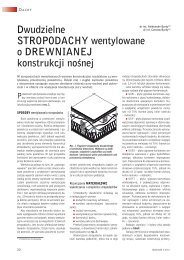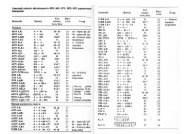Water content
Water content
Water content
You also want an ePaper? Increase the reach of your titles
YUMPU automatically turns print PDFs into web optimized ePapers that Google loves.
Soil Structure Interaction Division, Institute of Structural Mechanics, Civil Engineering Dept. Laboratory # 3 1/5———————————————————————————————————————————————————Cracow University of TechnologyTutorial date ………………………Passing date ………………………Number of points/mark ….……………………Name:Academic year: Group: Tutor:SOIL MECHANICS – LABORATORY # 3Fundamental soil parameters.Organic <strong>content</strong> determination.1. Terms and definitions1.1 <strong>Water</strong> <strong>content</strong>Geotechnics requires the water <strong>content</strong> [%] to be expressed as a percentage of the sample's dryweight i.emwmmt− mstw n = ⋅100% or wn=msmstwhere: m w - sample water mass [g],m s - sample solid particles mass [g],m mt - total sample mass [g],m st - sample mass of a soil oven-dried at 105 – 110 o C [g],1.2 Bulk densityThe test is used to determine the bulk (total) mass density of a soil ρ, including any liquid or gas contained.where: ρ - bulk density [g/cm 3 ],m m - total sample mass [g],V - total sample volume [cm 3 ],There are several methods of determination:ρ =m mV1.3 Soil particle densityThe soil particle density of a soil sample is calculated on the basis of the measurement of twoquantities: m s , the mass of the solid phase of the sample (dried mass) and V s , the volume of the solidphaseρ =smVss=mwtm+ ( mgg− mt− m ) − mtwg
Soil Structure Interaction Division, Institute of Structural Mechanics, Civil Engineering Dept. Laboratory # 3 2/5———————————————————————————————————————————————————where: m s - soil particle mass [g],V s - soil particle volume [cm 3 ],m g - mass of a pycnometer with soil oven-dried at 105 – 110 o C [g],m wt - mass of a pycnometer with water [g],m wg - mass of a pycnometer with soil and water [g],m t - mass of a oven-dried pycnometer at 105 – 110 o C [g],1.4 Solid material densitySolid material density namely ρ d isIn practise the following formula is used:1.5 Porosity of soilPorosity of soil namely n [-] is ...1.6 Void ratio of soilVoid ratio of soil namely e [-] is...1.7 The formula linked the porosity and void ratio
Soil Structure Interaction Division, Institute of Structural Mechanics, Civil Engineering Dept. Laboratory # 3 3/5———————————————————————————————————————————————————2. The tests due to PN-88/B-04481.2.1 Determination of the water <strong>content</strong> of the soilEquipment and description of procedure:(The results are written on the separate sheet)2.2 Determination of the bulk (volume) density of the soil2.2.1 Determination of the volume density of the soil by a ring and/or a cylinderEquipment and description of procedure:(The results are written on the separate sheet)2.2.2 Determination of the bulk density of the soil by a hydrostatic lift in waterEquipment and description of procedure:(The results are written on the separate sheet)2.2.2 Determination of the bulk density of the soil by a hydrostatic lift in organic fluidEquipment and description of procedure:(The results are written on the separate sheet)2.3 Determinatio of the particle density of soil solid by pyknometer methodEquipment and description of procedure:(The results are written on the separate sheet)
Soil Structure Interaction Division, Institute of Structural Mechanics, Civil Engineering Dept. Laboratory # 3 4/5———————————————————————————————————————————————————3. Calculcation of the parameters obtained during the tutorials# Fomula Data Value1 Soil sample no.2 Soil classification3 <strong>Water</strong> <strong>content</strong>4 Bulk density5 Soil particle density6 Solid material density7 Porosity8 Void ratio(Comment the results)3. Determination of the organic <strong>content</strong> (PN)Organic material is made of carbon compounds, which when heated to high temperatures orchemically treated are converted to carbon dioxide and water.Organic <strong>content</strong> I om is a ratio of dry mass of organic compounds to the total mass of solidsTable 3 Soil classification due to organic <strong>content</strong> (PN-EN ISO 14688-2: 2005)SoilOrganic material <strong>content</strong>(≤ 2mm) % of dry massLow-organic 2 do 6Mid-organic 6 do 20Highly-organic > 20
Soil Structure Interaction Division, Institute of Structural Mechanics, Civil Engineering Dept. Laboratory # 3 5/5———————————————————————————————————————————————————Methods of determination of I om :3.1 Organic <strong>content</strong> determination (I om ) by H 2 O 2 treatmentEquipment and description of procedure:(The results are written on the separate sheet)3.2 Organic <strong>content</strong> determination by furnacing (I ż )Equipment and description of procedure:(The results are written on the separate sheet)
Soil Structure Interaction Division, Institute of Structural Mechanics, Civil Engineering Dept. Laboratory #3<strong>Water</strong> <strong>content</strong> (w) and bulk density (ρ) of the soil determinationwith a ring and/or a cylinderSoil classificationSample No.: ………...............Place........... …………………………… Soil name:: …………………..……………….….....…Other components: ……………….………………..…. CaCO 3 <strong>content</strong>: .………….. Colour:………………………………......<strong>Water</strong> <strong>content</strong>: .……………….Plasticity/ Particle shape.:……......…………………………………………………………….....Consistency …………………………...………….…….........………………………………………………………….………Overall mass (sample+cylinder): m<strong>Water</strong> <strong>content</strong> # 1Container no..…… <strong>Water</strong> <strong>content</strong> # 2Container no..……total mass with wet soil (g) mmt ……..…. - mst .……................. total mass with wet soil (g) mmt ……..…. - mst .…….................total mass with dry soil (g) mst........... - mass of container mt…... total mass with dry soil (g) mst........... - mass of container mt…...w = ( - / - )*100 = % w = ( - / - )*100 = %Bulk density ρ determination by a ringBulk density ρ determination by a cylinderOverall mass (sample+ring) : m mtρ = m m / V = ………………. g/cm 3 ρ = m m / V = ………………. g/cm 3Ring mass: m t .Cylinder mass:mtm t .Soil sample mass: m mSoil sample mass:m mRing volume: V = cm 3Cylinder volume: V = cm 3Calculations ρ =Soil classificationSample No.: ………...............Place........... …………………………… Soil name:: …………………..……………….….....…Other components: ……………….………………..…. CaCO 3 <strong>content</strong>: .………….. Colour:………………………………......<strong>Water</strong> <strong>content</strong>: .……………….Plasticity/ Particle shape.:……......…………………………………………………………….....Consistency …………………………...………….…….........………………………………………………………….………Overall mass (sample+cylinder): m<strong>Water</strong> <strong>content</strong> # 1Container no..…… <strong>Water</strong> <strong>content</strong> # 2Container no..……total mass with wet soil (g) mmt ……..…. - mst .……................. total mass with wet soil (g) mmt ……..…. - mst .…….................total mass with dry soil (g) mst........... - mass of container mt…... total mass with dry soil (g) mst........... - mass of container mt…...w = ( - / - )*100 = % w = ( - / - )*100 = %Bulk density ρ determination by a ringBulk density ρ determination by a cylinderOverall mass (sample+ring) : m mtρ = m m / V = ………………. g/cm 3 ρ = m m / V = ………………. g/cm 3Ring mass: m t .Cylinder mass:mtm t .Soil sample mass: m mSoil sample mass:m mRing volume: V = cm 3Cylinder volume: V = cm 3Calculations ρ =Tested by: …………………..…..…....….… Group …………….. date. ….………….………….Checked by: ……..……………………………………….…………date. ……………….………..


